 W
WAcanthorhachis is an enigmatic extinct genus of chondrichthyan from the Carboniferous period. Its name is derived from the Greek word acanthos meaning "spine" and the Greek suffix for spine, -rhachis. This is due to the spine-like dermal denticles and their subsidiary spines, which coated the exterior of the animal. The authors who erected this genus suggested the common name "The Spiny Spined Shark." It is closely related to Listracanthus. It differs from it in the size, structure, and distribution of dermal spines. It is currently monotypic, containing only the species A. spinatus. This shark is thus far only described from the British Isles. Acanthorhachis was first described from the Westphalian-aged lower coal measures of Yorkshire, England. It occurs rarely in Viséan-aged Eyam Limestone of Derbyshire, England.
 W
WAntiquaobatis is an extinct genus of ray from the Early Jurassic of Europe, containing the single species A. grimmenensis. It is the oldest known described member of the Rajiformes, and is based on a single tooth from Pliensbachian of Northern Germany. It was recovered from the Grimmen Clay Pit, on Spinatum strata that belongs in the region to the Komorowo Formation. The holotype is a single antero-lateral tooth, very small and slightly asymmetrical, measuring 0.25 mm in maximum height and 0.26 mm in maximum width, that has an overall morphology, that suggests a consistent referral to Batomorphii, encompassing all skates and rays. The tooth has an overall rather gracile crown morphology, different from any other know jurassic batomorphs, indicating closest affinities to the monotypic genus Engaibatis schultzei from the Kimmeridgian-Tithonian of Tanzania.
 W
WAquilolamna is an extinct genus of shark-like elasmobranch from the Late Cretaceous (Turonian)-aged Agua Nueva Formation of Mexico. It is currently known to contain only one species, A. milarcae, also known as the eagle shark, and it is classified in its own family Aquilolamnidae, which has been tentatively assigned to the mackerel sharks.
 W
WAsterodermus is an extinct genus of guitarfish from the Jurassic Period. A single species, A. platypterus, is described. It is known mainly from the early Tithonian of Germany, including the famous Lagerstätte site of Solnhofen. Additionally, Asterodermus scales have been found among articulated skeletons of neoselachians from the Tithonian of southern Germany.
 W
WAtlanticopristis is an extinct genus of sclerorhynchid that lived during the Middle Cretaceous (Cenomanian) of what is now the Northeast Region of Brazil, between 100.5 and 93.9 million years ago. Fourteen fossil teeth from Atlanticopristis were found in the Alcântara Formation, and referred to the closely related Onchopristis in 2007; a redescription in 2008 by Portuguese paleontologists Manuel Medeiros and Agostinha Pereira assigned it to a new genus containing one species, Atlanticopristis equatorialis.
 W
WBandringa is an extinct genus of Elasmobranch known from the Pennsylvanian subperiod of the Carboniferous period that was part of the monotypic family Bandringidae. There is currently a single known species, B. rayi, described in 1969. It is known from exceptionally preserved individuals found in the Mazon Creek Lagerstätte of Illinois which dates back to the late Moscovian stage; the holotype, a juvenile, was found by Ray Bandringa in an ironstone concretion during the summer of 1967. Two species from this genus were originally described, B. rayi and B. herdinae, but the differences between the two were found to be taphonomic in origin. All Mazon Creek individuals appear to represent juveniles, suggesting the area was a nursery for them. Also supporting this notion are fossilized egg cases found in the same localities, though it is unclear whether they belong to this genus. Adult fossils attributed to B. rayi have also been found in spoil heaps from Five Points coal mines near Conesville, Ohio and Cannelton, Pennsylvania, both of which contain the roughly contemporaneous Kittaning Formation of the Allegheny Group. This species has a long rostrum and may have been analogous to modern sawfish. It appears to have fed via suction feeding. Preserved gut contents include articulated arthropods. Estimated from the juvenile fossils and partial adult fossils, the adult is close to 70 cm (28 in). Its relationships to other elasmobranchs is currently unclear.
 W
WBarbclabornia is an extinct genus of xenacanth shark from the Early Permian and possibly upper Pennsylvanian of North America. It is named for Barbara Claborn who discovered a palatoquadrate allowing the genus to be described and Alvie Claborn who helped prepare it. The genus contains a single described species: B. luedersensis. It was originally placed in the genus Xenacanthus prior to the description of an associated dentition. It is believed to be closely related to Triodus. It was likely a mainly freshwater shark with a size much larger than its relatively small teeth would suggest. It is currently known only from North America but has been found in many places with Asselian and Atinskian formations including the Clear Fork, Albany, Wichita, and Dunkard Groups. There are possible examples from the Gzhelian-aged Admire, Monongahela, and Conemaugh groups.
 W
WBelantsea is a genus of extinct petalodontid cartilaginous fish that lived during the Lower Carboniferous, about 350 million years ago. Its fossils are found in the Bear Gulch Limestone lagerstätte. Its body was leaf-shaped, with muscular fins and a small tail. Such a body plan would allow for great maneuverability, but at the cost of speedy cruising. Its few, large, triangular teeth formed a beak-like arrangement that allowed it to graze bryozoans, sponges, crinoids, and other encrusting animals. The genus contains two species, B. montana and B. occidentalis.
 W
WBransonella is an extinct genus of marine Xenacanth shark which lived during the Paleozoic era. It is known only from teeth which are easily distinguished from related genera by ornamentation on the cusp shaped like an inverted "V" and fin spines Teeth attributed to this genus are small, no greater than 2 millimeters. This suggests a small body size likely not exceeding a meter in length. It has been suggested their lifestyle was similar to modern Catsharks. It was used to erect a new order along with Barbclabornia based on ornamentation.
 W
WCampodus is an extinct genus of eugeneodont holocephalans from the Carboniferous. Likely one of the earliest and most basal caseodontoids, it can be characterized by its broad, ridge-ornamented crushing teeth made of various types of dentine. The type species, C. agassizianus, was originally described in 1844 based on a small number of teeth from the Namurian of Belgium.
 W
WCaseodus is an extinct genus of eugeneodontid holocephalian from the Carboniferous of the United States and the Early Triassic of Canada. It was of medium size, measuring 1–1.5 m (3.3–4.9 ft) in length.
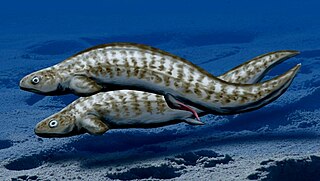 W
WChondrenchelys is an extinct genus of cartilaginous fish and the earliest member of Holocephali known from complete skeletons. Chondrenchelys would have been quite a relatively medium-sized fish with an elongated body up to 1 m (3.3 ft) in length, it had a dorsal fin which was indeed long and a body which tapered to a point. Chondrenchelys had two large pairs of tooth plates in each jaw.
 W
WCladodus is an extinct genus of cartilaginous fishes in the family Cladoselachidae. As the name implies, they are a type of cladodont, primitive sharks with teeth designed to snag fish and swallow them whole, instead of sawing off chunks to swallow.
 W
WCretalamna is a genus of extinct otodontid shark that lived from the Late Cretaceous to Eocene epoch. It is considered by many to be the ancestor of the largest sharks to have ever lived, Otodus angustidens, and Otodus megalodon.
 W
WCtenacanthus is an extinct genus of ctenacanthiform chondrichthyan. Remains have been found in the Bloyd Formation in Arkansas, United States and in South America.
 W
WCyclobatis is an extinct genus of stingray-like skate from the Upper Cretaceous of what is now Lebanon. The genus is typified by a circular form. The ray measures about 10 cm or 20 cm. In life the environment of this creature was a warm shallow sea. This fish had a very short tail, fitted with a venomous stinger.
 W
WDebeerius is a genus of debeeriid chondrichthyan from the Mississippian age Bear Gulch Limestone of Montana, United States. One species is known - D. ellefseni and its generic name honours Sir Gavin de Beer.
 W
WDelphyodontos dacriformes is a prehistoric holocephalid fish from the middle Carboniferous-aged Bear Gulch Limestone Lagerstätte, during the Bashkirian Stage in Montana. The adult form is unknown, as the only fossil specimens are of aborted fetuses or recently born young. Sharp teeth and fecal matter in the fossils suggests that Delphyodontos practiced intrauterine cannibalism, like some modern sharks, such as sand tiger sharks.
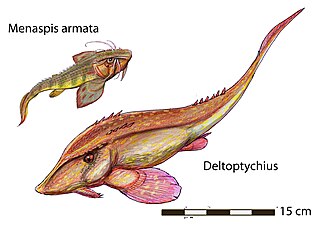 W
WDeltoptychius is an extinct species of cartilaginous fish related to the modern chimaeras. It lived in the Carboniferous period of present-day United Kingdom. Fossils of the genus have been found in the Glencartholm Volcanic Beds Formation of the Upper Border Group in Scotland.
 W
WDracopristis is a genus of extinct ctenacanthiform Chondrichthyes that lived during the middle to late Carboniferous. The fish had 12 rows of short, squat teeth, and an array of spines on its dorsal fins. Because it has features similar to reptiles and kaiju, the fish is often nicknamed the "Dragon shark" or "Godzilla shark." The main differentiation between Ctenacanths and true sharks is that Ctenacanth mouths are larger but less flexible than the true sharks. The spines of the holotype fossil are about 0.75 meters long, and the whole body was around 2 meters long.
 W
WEchinochimaera is an extinct genus of fish, it was assigned to the order chimaera by Jack Sepkoski in 2002. The genus' name derives from the Greek εχινό (echino) meaning spiny, and chimaera.
 W
WEdestus is an extinct genus of edestoid cartilaginous fish known from the Late Carboniferous (Pennsylvanian) of the United Kingdom, Russia, and the United States. Most remains consist of isolated curved blades or "whorls" that are studded with teeth, that in life were situated within the jaws. Edestus is a Greek name derived from the word edeste, in reference to the aberrant quality and size of the species' teeth. The largest species, E. heinrichi, has been conservatively estimated to reach greater than 6.7 m (22 ft) in length, around the size of the largest known great white shark.
 W
WExpleuracanthus is a genus of xenacanthidan shark. Its horn was probably used for protection against predators. The genus Expleuracanthus is a synonym of Xenacanthus.
 W
WFadenia is an extinct genus of eugeneodontid holocephalian chondrichthyan from the Carboniferous Period of Missouri, the Permian period of Greenland, and the Early Triassic epoch of Greenland and Sulphur Mountain Formation of British Columbia, Canada.
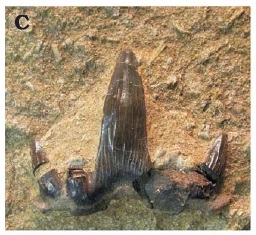 W
WGlikmanius is an extinct genus of cladodont shark which lived in the Carboniferous of North America and Russia. The genus is based on a whole specimen from Nebraska, USA. Glikmanius is named in honour of the Russian palaeontologist, Dr. Leonid Glikman, who studied the genus and was "the first to propose its ctenacanthiform affinity".
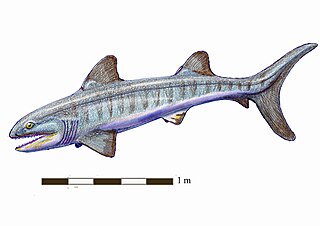 W
WGoodrichthys is a Carboniferous genus of shark from the Glencartholm Volcanic Beds Formation of Scotland.
 W
WHarpacanthus is an extinct genus of cartilaginous fish.
 W
WHarpagofututor is an extinct genus of cartilaginous fish from the Mississippian of North America.
 W
WHelicoprion is an extinct genus of shark-like eugeneodont fish. Almost all fossil specimens are of spirally arranged clusters of the individuals' teeth, called "tooth whorls", which in life were embedded in the lower jaw. As with most extinct cartilaginous fish, the skeleton is mostly unknown. Fossils of Helicoprion are known from a 20 million year timespan during the Permian period from the Artinskian stage of the Cisuralian to the Roadian stage of the Guadalupian. The closest living relatives of Helicoprion are the chimaeras, though their relationship is very distant. The unusual tooth arrangement is thought to have been an adaption for feeding on soft bodied prey, and may have functioned as a deshelling mechanism for hard bodied cephalopods such as nautiloids and ammonoids. In 2013, systematic revision of Helicoprion via morphometric analysis of the tooth whorls found only H. davisii, H. bessonowi and H. ergassaminon to be valid, with some of the larger tooth whorls being outliers.
 W
WHelodus is an extinct genus of cartilaginous fish from the Upper Devonian through Lower Permian. While the type species, H. simplex is known from an articulated specimen, the rest of the species in this genus are known entirely from isolated teeth. Over twenty species have been attributed to this genus, many of which may be anterior teeth of other cartilaginous fish. This makes Helodus a wastebasket taxon. For this reason, only the type species can be confidently attributed to this genus until articulated remains of other species are found. H. simplex was around 30 centimeters long.
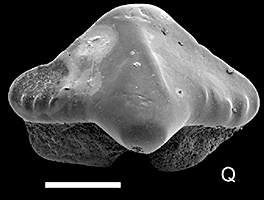 W
WIberotrygon is an extinct genus of sclerorhynchiform ray from the Cenomanian Mosqueruela Formation of Spain. Only the single species I. plagiolophus, is known; it was named and described in 2009. It is known from the holotype MPZ 2005-33, an antero-lateral tooth, and the parartypes MPZ 2005-34, four well-preserved teeth from a single juvenile?, and MPZ 2005-35, an isolated tooth.
 W
WIschyodus is an extinct genus of cartilaginous fish belonging to the subclass Holocephali, which includes the modern-day chimaeras. Fossils are known from Europe, North America, and New Zealand.
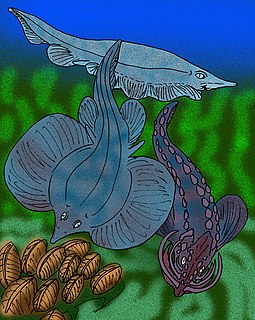 W
WJanassa is an extinct genus of petalodont cartilaginous fish that lived in marine environments in what is now central United States of America and Europe during the Carboniferous and upper Permian.
 W
WLibanopristis is an extinct genus of ganopristid sclerorhynchoid that lived in Lebanon during the Late Cretaceous.
 W
WListracanthus is a genus of extinct chondrichthyan with uncertain affinities. Species of Listracanthus are known primarily from their tremendous, feather-like denticles, which range up to four inches in length. The denticles had a large main spine, from which secondary spines emanate from the sides, like the barbs of a feather or a comb. Listracanthus first appeared in late Carboniferous strata in North America, and eventually disappear from the fossil record some time during the Early Triassic.
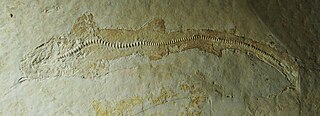 W
WMacrourogaleus is a genus of palaeospinacid shark from the Late Jurassic Solnhofen Limestone. It is probably related to Paraorthacodus due anatomical similarities seen in whole-body fossils of both genera.
 W
WMenaspis is an extinct genus of holocephalian cartilaginous fish from the Permian.
 W
WMicropristis is an extinct genus of ganopristid sclerorhynchoid that lived in the Middle East and Europe during the Late Cretaceous.
 W
WMyledaphus is a genus of Late Cretaceous cartilaginous fish whose fossils are known from Canada, the Midwest of the United States, Olmos Formation of the Difunta Group of Mexico, and the Beshtyubin and Bissekty Formations of Uzbekistan. It was a freshwater guitarfish that probably reached a length of 3 feet (91 cm), and had teeth adapted for a durophagous diet of animals such as clams. Most taxonomic authories place the genus in the Rhinobatidae. Two species are known: Myledaphus bipartitus, the type species, and Myledaphus araucanus, named in 2019.
 W
WOnchopristis is an extinct genus of sclerorhynchoid from the Cretaceous of North Africa, Europe, and North America. It contains two valid species, O. numida and O. dunklei. Onchopristis first appeared in the Barremian and its latest occurrence dates to the Campanian, making it one of the oldest and longest-lived sclerorhynchoid genera. Like other sclerorhynchoids, it had a long rostrum with large denticles similar to sawfishes and sawsharks. This feature was convergently evolved and its closest living relatives are actually skates. Isolated rostral denticles are the most common fossils of Onchopristis, but rostra, chondrocrania, jaws, oral teeth, vertebrae, and dermal denticles have also been found.
 W
WOnchosaurus is an extinct genus of sclerorhynchid sawfish from the Late Cretaceous. Its fossils have been found in the Cretaceous sediments of Egypt, Morocco, France, Niger, Japan, Chile, Peru and the United States.
 W
WOrnithoprion is an extinct genus of eugeneodont holocephalan closely related to Caseodus. It lived in the Moscovian stage of the Carboniferous from 315.2 to 307 million years ago. Various species had an elongated lower jaw. The discovery and description of Ornithoprion helped establish many aspects of eugeneodont skull anatomy, which previously could only be gleaned from tooth data.
 W
WOrodus is an extinct genus of cartilaginous fish that lived from the late Pennsylvanian to the early Permian in what is now North America. Growing up to 2 m (7 ft) in length, it was quite large for sharks of its time.
 W
WOrthacanthus is an extinct genus of fresh-water xenacanthid sharks, named by Louis Agassiz in 1836, ranging from the Upper Carboniferous until the Lower Permian. Orthacanthus had a nektobenthic life habitat, with a carnivorous diet. Multiple sources have also discovered evidence of cannibalism in the diet of Orthacanthus and of "filial cannibalism" where adult Orthacanthus preyed upon juvenile Orthacanthus. The genus Orthacanthus has been synonymized with Dittodus, Didymodus, and Diplodus.
 W
WParahelicoprion is an extinct genus of shark-like eugeneodontid holocephalids from the Permian of the Ural Mountains and Copacabana Formation, Bolivia. The genus name, from "nearly coiled saw" in Greek, directly refers to Helicoprion, a related holocephalid that shares similar traits to it, including the helical whorl of teeth.
 W
WPseudorhina is an extinct genus of stem angel shark seemingly restricted to the Mesozoic of Europe. It is represented by several articulated individuals as well as isolated teeth. There are four species.
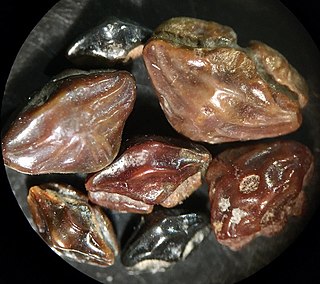 W
WPtychotrygon is a genus of sawfish-like Late Cretaceous ray whose fossils have been found worldwide. It, Ptychotrygonoides, Texatrygon, and Asflapristis are members of the family Ptychotrygonidae within the suborder Sclerorhynchoidei.
 W
WPucapristis is a prehistoric genus of sclerorhynchid ray whose fossils first appear in the fossil record in rocks dating from the Maastrichtian stage. The genus was described in 1963 by Schaeffer. Fossils of Pucapristis have not been found in any subsequent strata. Incidentally, the Maastrichtian is the final portion of the Cretaceous Period and its endpoint marks the advent of the Cretaceous–Paleogene extinction event. This major geological transition is famous for being the mass extinction that wiped out the dinosaurs.
 W
WRajorhina is an extinct genus of stingray-like skate from the Upper Cretaceous of what is now Lebanon. It is the only known fossil-only genus of the family Rajidae The genus is typified by a Rhombus form.
 W
WSarcoprion is an extinct genus of eugeneodontid holocephalids from the Permian of Greenland. Similar to other eugeneodontids such as Edestus and Helicoprion, it was best known for its extremely bizarre tooth morphology compared to other species of sharks and their closest relatives, the chimaeras. Compared to other members of the Helicoprionidae, its "tooth whorls" were found to be sharper, more compact, and in better condition than other sharks of the time, and refrained from growing to extremely unwieldy forms that would raise questions about its ability to feed properly. The genus contains one species, Sarcoprion edax, found in Permian-aged marine strata of Meddelelser om Grønland.
 W
WSpathobatis is an extinct genus of ray from the Jurassic period of Europe.
 W
WSphenacanthus is an extinct genus of a chondrichtyan xenacanthiform that belongs to the Sphenacanthidae family and lived from the Late Devonian, through Carboniferous until the Late Permian period in Scotland, Spain, Russia and Brazil. It lived 359 million years ago, and probably it was one of the first member of the elasmobranchians, the lineage that leads to the modern sharks. Sphenacanthus probably hunts small fishes and, unlike their modern-day relatives, its inhabited fresh water lagoons. Sphenacanthus had seven fins, two in the upper part and five in the underside, and it have a heterodont dentition and mandibles relatively long and deeper. Sphenacanthus serrulatus is still only known from incomplete neurocranial remains and associated dermal material. These suggest that it was a relatively large shark, probably well over one meter in length when fully grown. Its body form was probably similar to that of other phalacanthous sharks.
 W
WSqualoraja polyspondyla is an extinct chimaerid from the Lower Jurassic of Europe. Fossils of S. polyspondyla have been found in Lower Jurassic-aged marine strata of Lyme Regis, England, and Osteno, Italy.
 W
WTitanonarke is an extinct genus of large electric rays known from the Ypresian age of the Eocene epoch. It currently contains two species from the Bolca Lagerstatte of Italy, T. molini and T. megapterygia. The exceptional preservation of multiple entire individuals has allowed a detailed reconstruction of their lives. Specimens of both species have been found with various ontogenetic stages and with parasitic isopods preserved. One specimen contains a fossilized embryo, showing this species to be viviparous. This species seems to prefer shallow water habitats associated with coral reefs, not unlike modern relatives. Stomach contents reveal a diet which included an extinct large benthic foraminifera genus, Alveolina.
 W
WXenacanthus is a genus of prehistoric sharks. The first species of the genus lived in the later Devonian period, and they survived until the end of the Triassic, 202 million years ago. Fossils of various species have been found worldwide.